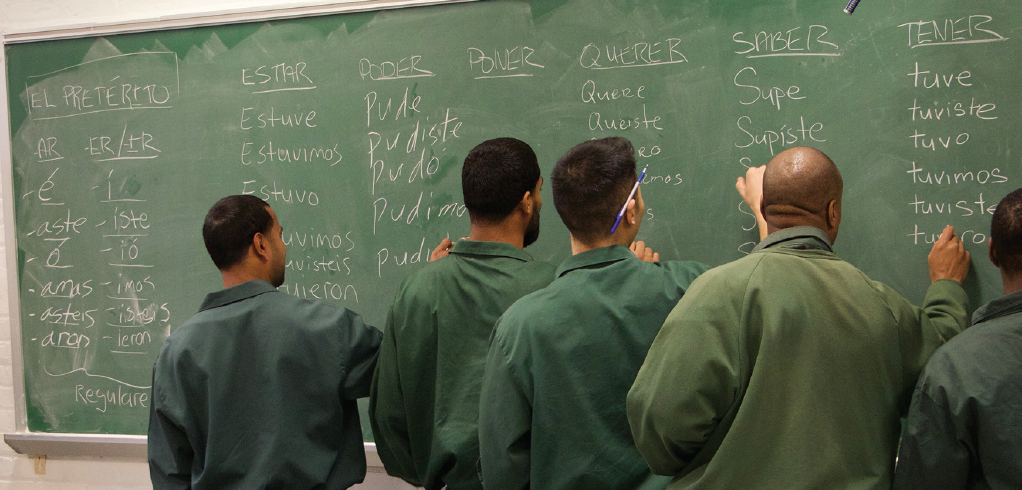In the era of mass incarceration, America is the world’s largest jailer. With more than 2 million men and women behind bars, 630,000 are released annually and nearly 50 percent end up back in prison within five years, in a cycle of imprisonment, release and re-incarceration. College Behind Bars, a new documentary series from Lynn Novick, widely known for her work with Ken Burns, tells the story of a small group of incarcerated men and women struggling to earn college degrees and turn their lives around in the Bard Prison Initiative (BPI), one of the most rigorous and effective prison education programs in the United States. “Lynn has provided us with a transformative story about the power of education and how it can change lives and also benefit society at large,” says Executive Producer Ken Burns. “Programs like the BPI are sorely lacking in our criminal justice system. College Behind Bars could not be coming out at a more perfect time.” - PBS/WETA
by Katy Beem
Since 1994, prisoners have been banned from receiving federal Pell Grants and, subsequently, many prisons and colleges reduced their postsecondary programs. The Federal Prison Camp (FPC) in Yankton is one of only six Federal Bureau of Prisons nationwide to host an Artist- In-Residence program funded by the National Endowment for the Arts (NEA). In tandem with the FPC’s Education Department, which offers apprenticeships in areas like plumbing and HVAC and undergraduate certificates in business management and horticulture, the NEA program features an intensive 10-month creative writing and publishing class. Taught by Mount Marty College English professor and writer Jim Reese for the last 12 years, the weekly, three-hour class culminates in 4 P.M. Count,a journal of art and writing. The cover of the 2018 edition features the colorful prisoner-landscaped gardens at the FPC. A foreword from Warden Heriberto H. Tellez says the program “has helped over 200 incarcerated men heal through self-reflection and expression.” Some prisoner-students take the writing and publishing class several years in a row.
Reese, whose college career arced from a freshman criminal justice major to a doctorate in English, says working closely with inmates altered his original worldview of the incarcerated. “I don’t have the authority to speak on all heinous criminals, but I can tell you what I know from my own initial fears,” says Reese, who has also done outreach at San Quentin. “Until I started working in the prisons, I had a one-sided view that all criminals were wicked people. But most prisoners aren’t heinous animals. Most aren’t wicked criminals.”
In the months the student-inmates write for and design the 200+ pages of 4 P.M. Count, Reese gives them writing prompts. He says they are typically questions the inmates have never had to answer, usually because they’ve never been asked. In fact, “something no one ever asked me,” is one of the prompts. “We share a lot,” says Reese. “‘I fear — and then you fill in the blank. ‘I’m afraid so-and-so will show up on my doorstep.’ I gear them towards those guys thinking about themselves. They don’t have to write about themselves, but 80-90% of them do, about why they’re there and what they’ve learned.”
Although Reese imparts communication and writing skills to the inmates, he says teaching can naturally veer toward a kind of psycho-social cheerleading. “I always have to remind myself that it’s a creative writing class,” says Reese. “I spend a lot of time talking about people like Brendan Burchard, one of the best high performance coaches in the country. I talk to them a lot about life planning skills and turning their life around. Even if they’re in prison, how they can start thinking positively.”
Reese says he comes down firmly on the side of providing education in prison. He cites many prisoners in the state’s penitentiary have been convicted of drug-related crimes stemming from addiction. “Locking them up isn’t going to fix that. A five-year, bipartisan study by the Rand Corporation showed every dollar spent on education equates to $4 or $5 taxpayer savings. You can teach somebody how to be a plumber, that’s good – but that doesn’t help deal with the true problem, which could be any number of things.”
Reese also acknowledges no simple answers. “Some people are beyond rehabilitation.” He references drug-related and premeditated murders, and a high school acquaintance who raped and killed Christina O’Day in 1990s Omaha, a subject Reese discusses in his new book, Bone Chalk.“Do I think a guy like him needs to stay in prison for the rest of his life? Yes, I do. But that is a small percentage of people.”
Reese lets his prisoner-students know this work is why he gets up in the morning. “When you help somebody write something that really can change their life for the better, it’s not just a poem that’s nice, not just a short story that’s entertaining — it’s working on a different level. If you can do that, it’s really going to affect their family and their future, that’s pretty cool to give them those tools to utilize or help them to discover those skills that they maybe have already.”



